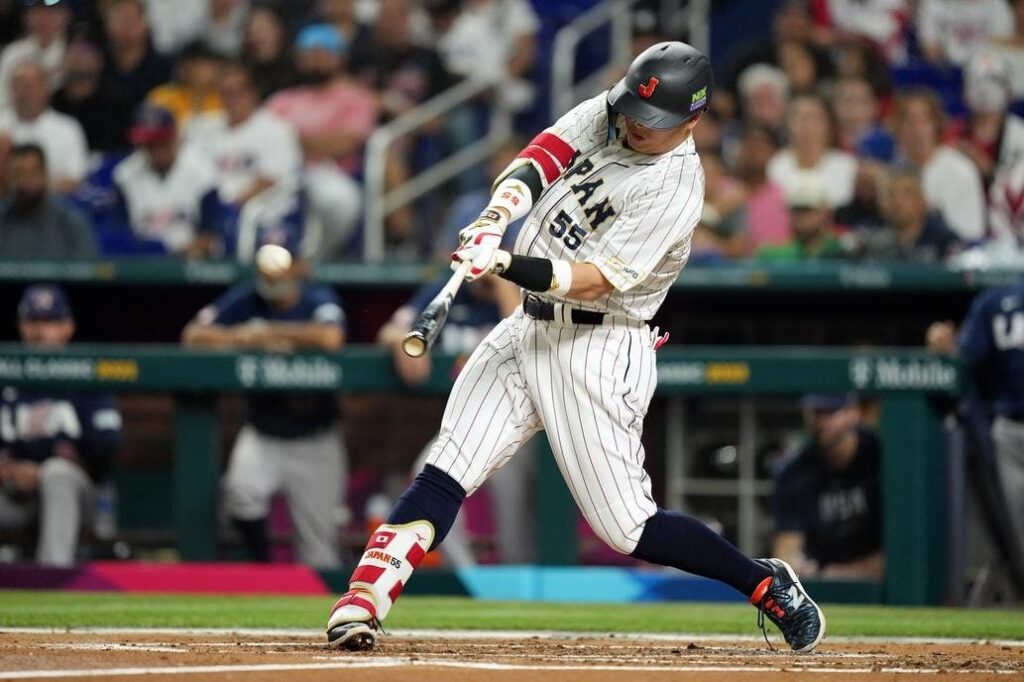
Free agent Munetaka Murakami, a corner infielder with a big bat, seeks to sign with a U.S. team after starring in Japan. (Photo by Eric Espada/Getty Images)
Getty Images
For the vast majority of baseball fans, they are the four free agents nobody knows. Yet they could tip the balance of power in the 2026 title chases.
All four played in Japan’s major leagues last year but now, after posting by their teams, hope to follow Shohei Ohtani, Yoshinobu Yamamoto, and Yu Darvish to teams in the United States.
The names to know are pitchers Tatsuya Imai and Kona Takahashi plus position players Munetaka Murakami and Kaz Okamoto.
Now on the free-agent market, they are widely considered among the best potential signees in a sea of accomplished veterans – even though nobody knows how they will handle the transition to American baseball.
None has the potential of Ohtani, a pitcher/DH who won four MVP awards – all by unanimous vote – with the last three coming in consecutive seasons.
Nor does any project to duplicate the heroics of Ichiro Suzuki, who missed unanimous election to the Baseball Hall of Fame last year after becoming the first Japanese-born position player to succeed in the U.S. majors.
But all four are generating substantial interest from teams hoping to catch lightning in a bottle by paying the posting fee set by their Japanese teams and then signing them to American contracts.
High Rating
One of the new arrivals was actually rates No. 2 on Jon Heyman’s list of Fifty Top Free Agents published in The New York Post on Nov. 10. That would be Imai, a 27-year-old right-handed pitcher who posted a microscopic 2.10 earned run average over the last four seasons.
Heyman projects he’ll land an eight-year contract worth $200 million.
In the same column, the veteran baseball writer also suggested Murakami could earn $150 million over six years and Okamoto $100 million over five. Heyman lists them as No. 9 and No. 12 on his list.
Murakami might be the Japanese version of former Philadelphia DH Kyle Schwarber, who is also on the this year’s free-agent market. But he’s much younger at age 25 – five years younbger than Murakami. The Japanese slugger smacked 56 home runs in 2022 but also strikes out frequently (180 times in 2024). Still, he’s the only player since Sadaharu Oh in 1977 to win Central League MVP honors by unanimous vote.
Right-handed slugger Kaz Okamoto is one of four star players from the Japanese majors hoping to jump to U.S. teams for 2026. (Photo by Megan Briggs/Getty Images)
Getty Images
Okamoto, like Murakami, is a corner infielder whose calling card is his bat. He makes better contact, however, and is considered a better defensive third baseman.
Filling A Void
If the New York Mets lose free agent Pete Alonso, they could sign either player to be their first choice at first base for 2026. Either Japanese slugger could also wind up as a designated hitter – a role that could interest the Atlanta Braves after the sudden slide of aging Marcell Ozuna.
The Boston Red Sox, also seeking a first baseman, offer the enticement of The Green Monster, a left-field wall that stands 37 feet high but agonizingly close to home plate for right-handed sluggers. Citizens Bank Park, home of the Philadelphia Phillies, could also prove a perfect match for a free-agent slugger seeking a new home address.
As for the pitchers, the right-handed Takahashi could follow the example of Roki Sasaki, a 2025 rookie who made a sudden but successful conversion from starter to reliever for the Los Angeles Dodgers during their World Series victory over the Toronto Blue Jays.
At 29, he’s a year older than Imai. Takahashi’s earned run average in 2025 was an impressive 1.92.
The quartet of Japanese stars could seek the comfort zone of joining teams with one or more of their countrymen.
Comfort Zone
The Dodgers, for example, won their second straight world championship on the back of Ohtani’s 55-homer season and Yamamoto’s three wins as a pitcher in the World Series. Sasaki, another important contributor, should play an even larger role in 2026 if he returns from relief duty to the starting rotation.
As the top-paying team in the big leagues, Los Angeles also has appeal to prospect free agents. Yamamoto, for example, owns the largest contract ever given a pitcher: 12 years at $325 million. According to Roster Resource, the team’s projected 2026 payroll is $332 million.
Proximity to Japan has helped the Seattle Mariners sign a slew of players from Nippon Professional Baseball. In addition to Ichiro, a two-time batting champion, they include MLB All-Stars Kazuhiro Sasaki, Yusei Kikuchi, Hisashi Iswakuma, and Shigetoshi Hasegawa.
Since pitcher Masanori Murakami became the first player to jump from the Japanese leagues to the U.S. majors in 1964, when he joined the San Francisco Giants, more than 70 players have made the same journey.
Shohei Ohtani celebrates with dog Decoy after capping his fourth MVP season with his second straight World Series ring. (Photo by Harry How/Getty Images)
Getty Images
In addition to Ohtani, who has won four MVP awards, and Ichiro, one of two players to win MVP and Rookie of the Year honors in the same season, the group includes Hideki Matsui, a former World Series MVP, and Hideo Nomo, who pitched no-hitters in both the American League and National League. Matsui and Yamamoto are the only Japanese natives to win World Series MVP awards.
All 30 U.S. clubs have had at least one Japanese-born player. The best of the current group includes Yu Darvish, Seiya Suzuki, Kodai Senga, Masataka Yoshida, Tomoyuki Sugano, and Shota Imanaga, in addition to Ohtani, Yamamoto, and Sasaki.
With posting windows for the four new hopefuls expected to stretch into early January, quick signings are not likely.


AloJapan.com